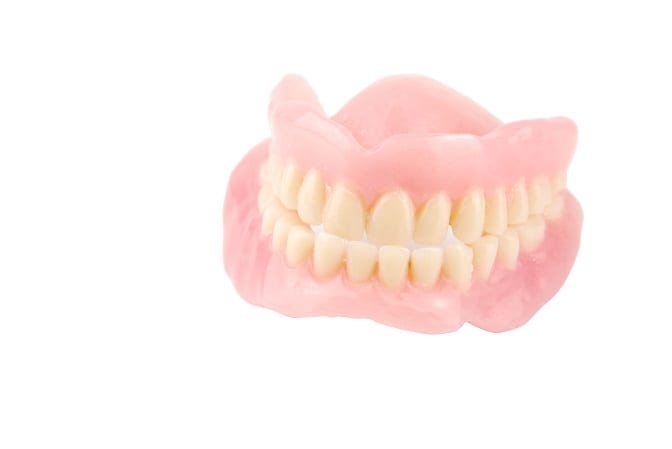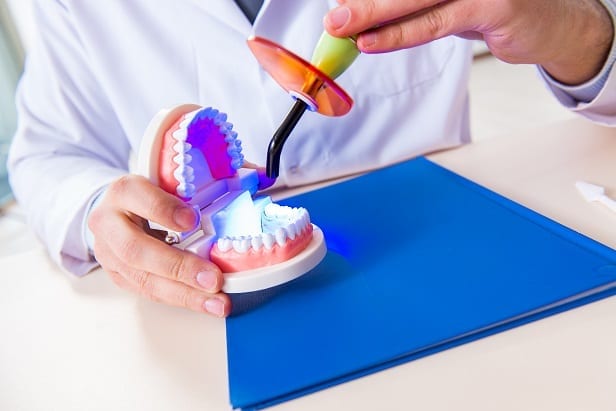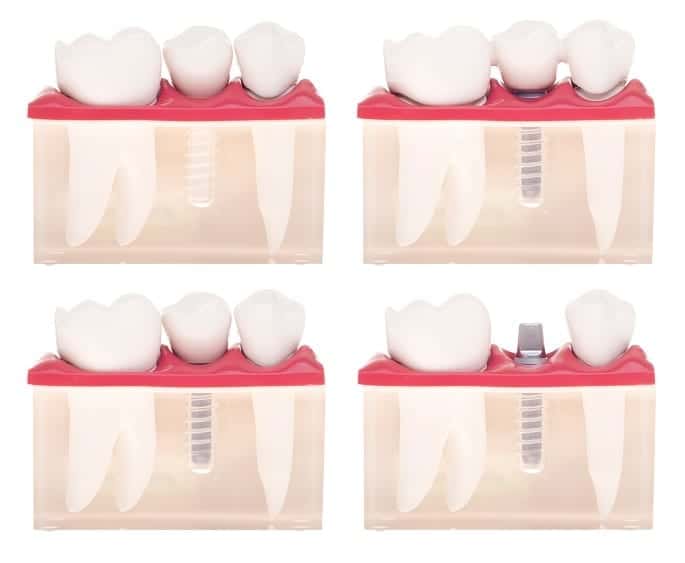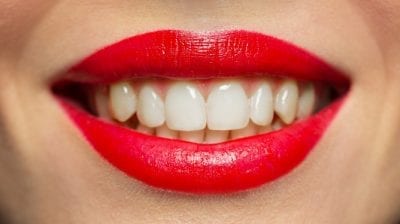If you’re missing teeth and its surrounding tissues due to intentional extraction, accidental removal, or tooth decay, getting a denture is one of the best solutions to fill in those gaps. You can either avail of dentures that are removable (like what senior citizens choose) and can be placed into a glass of water – or you can get something more permanent that’s anchored unto your gums and jaw through what is called as a dental implant.
Implants typically require dental surgery to place, which is why most seniors who can’t take surgery until they absolutely have to opt for the removable variety of dentures. Speaking of which, there are two types of dentures you can avail of, which are partial and complete dentures. The complete ones are used when all the teeth are missing. Meanwhile, partial dentures are used when there are still some natural teeth remaining.
Page Contents
Complete Dentures

The traditional complete denture is mostly availed of those with advanced age. It is designed to replace all of the natural teeth of the patient who’ve lost them. They are placed on top of gums instead of bridges that are anchored to existing teeth or via dental implants. They’re typically placed within 2-4 months after tooth removal, extraction, or loss.
Complete dentures are usually of the removable variety because once you, for example, put in dental implants over them to affix them unto your mouth they then become partial dentures using implants as anchors by default. If you’re looking into getting permanent dentures installed on a toothless mouth, you might need to look into dental implantation to help you out.
You can avail of complete dentures as either immediate or conventional types.
- Conventional: A conventional denture is usually made after teeth removal and the gum has begun to heal. It’s typically ready for placement within your mouth in 8-12 weeks after teeth extraction.
- Immediate: Immediate dentures are manufactured in advance and can be put into your mouth as soon as teeth extraction has taken place. You won’t have to end up toothless during the gum healing period.
Do keep note that after extraction, gums and bones shrink over time, particularly during the period of healing that follows after a tooth has or teeth have been removed. There’s therefore a disadvantage with immediate dentures compared to conventional ones in terms of adjustments. Because conventional dentures take weeks to get manufactured, your future checkups in the clinic allow the dentist and the dental lab to make adjustments to your gum and bone shrinkage that they can’t do on short notice.
Because of the healing process, you should use immediate dentures as temporary solutions and conventional dentures as the more permanent ones that can actually adjust to the final shrinkage of your bone and gums. However, immediate dentures have the advantage on terms of giving you new teeth on the same day that your remaining teeth have been extracted, removed, or lost. Alas, the dentist needs to check first if you’re the proper candidate for this denture type.
Partial Dentures
A bridge or removable partial denture is typically called for if the patient still has some of his natural teeth left instead of having all of them gone. It could be one or more of them. The two pieces that hold the denture in the mouth are the metal piece and the pink-colored base. These come with the following functions and benefits:
- Metal Framework: A bridge typically consists of replacement teeth that you’re supposed to attach to a gum-colored or pink plastic base that is at times linked by a metal framework to hold the false teeth in place in your mouth.
- Natural Teeth Anchors: Bridges are used when one or several natural teeth remain in your mouth’s upper and lower jaws. These teeth are shaved down to serve as abutment for the crown that anchors the rest of the dentures into the mouth.
- Usage of Dental Cement: The dental bridge used on your natural teeth to fill in the gaps between teeth is cemented into place with dental cement so that they won’t easily be removed or pop off from the biting forces of your mouth.
- Removable Partials: Some partials can be conveniently removed, like they’re the dental equivalent of a toupee. Whether they’re permanent or not, both partial types assist in the prevention of teeth shifting or moving. They’re also made of partially acrylic or all-acrylic material.
- Replaces Multiple Teeth with a Bridge: The beauty of partial dentures is that they replace one or several teeth by crown placement on the teeth on either side of the space by attaching artificial teeth with a crown cap over the natural teeth, resulting in a bridge of sorts.
- Prevents Teeth Shifting: Whenever you lose a tooth or two, the rest of the teeth will over time gradually shift to fill in that missing space, leading to bigger and wider tooth gaps. A partial denture can be used to fill in those spaces and prevent the changes in teeth position.
Custom Dentures

The more expensive alternative to complete and partial dentures are custom dentures. The extra cost comes from them being made of more expensive material and being even more custom-fitted to your mouth than even conventional complete dentures. You’re essentially paying for them to ensure that your smile in the end looks more natural-looking.
It’s a type of denture you can check out before its completion virtually or as a preview of what you’ll end up with when push comes to shove. This is because it’s customized for your smile through digital oral scans or traditional molding techniques. Customization makes your dentures not only look more natural but feel more natural too when you put the in your mouth.
Implant-Supported Dentures
As discussed above, you can get partial bridge dentures even if you’ve lost all your teeth by putting in a dental implant that serves as an artificial tooth root unto the tooth socket. You can then place a crown or an entire dental bridge over the anchor to securely support them. Implants ensure that the denture looks natural and feels sturdy within your mouth.
It’s a solid foundation if you have enough bone and jaw mass left to allow for the dental surgery. If not, bone and gum grafting might be called for in order to make up the difference and ensure that there’s more material that your implant can use to stay attached to your jaw. It ensures that your bridge will last you a long time as well.
Snap-In Dentures
In terms of stability despite removability, snap-in or precision partial dentures are highly effective. They’re securely held in place with the assistance of anchors on existing teeth or dental implants. They’re different from partial permanent dentures that are cemented into place due to their locator attachments that are embedded within the denture’s tissue side. The following are characteristic of snap-in dentures:
- Attachments: A precision partial denture stays in place within your mouth with internal attachments instead of clasps that allow it to attach to adjacent crowns. This results in dentures that look more natural in your mouth. Its attachments snap into place of the locator receptors or implants, which means they’re removable and convenient yet pretty solid.
- Convenient and Removable: Despite the lack of permanency and dental cement, these dentures and their locator attachments snap solidly unto the receptors or implants. They feel like permanent natural teeth despite their removability, which also makes them easier to clean compared with their cemented counterparts.
- Used for Toothless Patients: These dentures are usually used for patients without any teeth even though it can also be used as a partial denture. They’re actually best used as implant-supported dentures, so if you lack bone to support an implant it’s usually better to go for complete conventional dentures.
Other Notable Dentures Types
Here are the other denture categories available to you. Use them in accordance to your unique needs and circumstances. However, it’s best that you consult with your dentist first before deciding whether the following are the best denture options for you.
- Overdentures: An overdenture is a type of denture that sits atop your gums and held into place with dental implants. They can be placed on the upper jaw (maxillary) or lower jaw (mandible) depending on what’s needed. An overdenture is also typically removable.
- Upper Dentures: Upper dentures are dentures for your upper teeth specifically. They’re usually more common that lower dentures and they are specifically made to deal with missing front upper teeth or the teeth that are most likely to go missing and become most noticeable whenever you smile.
- Economy Dentures: These dentures are optimized to make sure you get a cost-effective solution to your denture needs. These are generic dentures, which means they might not fit comfortably or securely in your mouth. They also tend to look fake compared the more natural-looking dentures.
To secure their fit in your mouth, denture adhesive will be called for. They’re the opposite of custom dentures, such that the more customized your dentures are the more expensive they’ll become and vice-versa. Indeed, if you can deal with fewer customizations from your denture, you can save a lot in dental costs.
FAQ Regarding Dentures

Here are some Frequently Asked Questions regarding dentures as well as their respective answers.
- How Are Dentures Made? It takes several appointments and a few weeks in order to develop the right denture for you, particularly when it comes to the best custom-fit conventional or partial dentures. Once your prosthodontist and dentist determines the best denture for you, you will undergo the following steps for denture application.
- Jaw Impressions: A mold will be made of your jaw or it can get digitally scanned in order to get the proper measurements of how they relate to one another, how much space is between them, and what type of bite you have.
- Patterns, Forms, or Models: According to the molds or scans, the dental lab will then create plastic patterns, wax forms, or models in the exact position and shape of the denture being made. You can try out the model several times.
- Customization and Casting: Across the 8-12 weeks, the denture will be customized in accordance to fit, shape, and color before casting the final denture. The final denture will then be cast, with adjustments being made to it as required.
- What Do New Dentures Feel Like? For the first few weeks, expect your new dentures to feel loose or odd. It will continue to feel this way until the muscles of your tongue and cheeks have learned to keep them in place. Soon enough, you should feel comfortable inserting and removing them. Even when it comes to permanent dentures that don’t require removal, this is the case.
It’s also not unusual for novice denture wearers to experience soreness or minor irritation in the beginning. Saliva also tends to increase when you first start wearing these dental appliances. As you acclimate with denture usage, these problems will naturally fade away over time. Just tough the whole ordeal out for a few weeks or so.
- Will Dentures Make You Look Different? Sometimes, but only if that’s your intention. Dentures are made to closely resemble your natural teeth, so unless you’re using the cheapest of economy dentures, there should only be a small noticeable change in how you look like. Truth be told, dentures can cosmetically improve the aesthetics of your smile, filling out your facial appearance in all the right ways.
Alternatives and Insurance

Dental implants are available to support bridges, eliminating the need for a partial removable denture. They cost more because dental implantation surgery is expensive and requires multiple experts to do. However, they make the crown anchor to the abutment and denture bridge fit better and feel more natural compared to economy dentures and their need of denture adhesive.
The dental implant is the most expensive denture. However, not everyone is eligible for implants. In particular, those who can’t undergo surgeries due to heart ailments or lack enough bone mass cannot avail of implants. Consult your dentist for more information. As for insurance, most of them cover some or the whole denture cost depending on your plan. Contact your company to find out the specifics regarding coverage.
Thantakit International Dental Center is Thailand’s longest established dental center. Situated in Bangkok, our clinic is renowned across the world as a destination for world-class dentistry, with most of our patients flying to us from Australia.
Please contact us today and get a FREE dental consultation.












